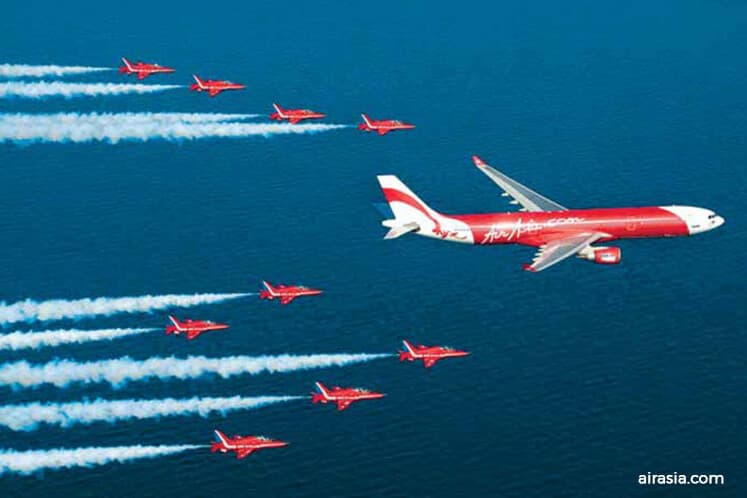
=KUALA LUMPUR (May 25): AirAsia Bhd, Asia's largest budget airline, saw net profit drop 29.8% to RM615.81 million or 18.4 sen a share in the first quarter ended March 31, 2017 (1QFY17) from RM877.79 million or 31.5 sen a share a year ago, mainly due to higher fuel cost as average fuel price rose 20% to US$67 per barrel in 1QFY17 from US$56 per barrel in 1QFY16 and a strong US dollar.
Staff costs also went up sharply by 27% to RM363.5 million in 1QFY17, mainly due to revised staff remuneration package that was introduced in 4QFY16.
As a result, total net operating profits fell to RM267.1 million in 1QFY17 from RM337.7 million in 1QFY16.
However, the airline remains positive of its prospects in 2017 and is optimistic that the 2017 results may surpass that of 2016, it said in a filing with Bursa Malaysia today.
For the remaining quarters of 2017, AirAsia said it remains optimistic as it continues to observe strong demand across most sectors coupled with a favourable fuel price and foreign exchange environment.
It is projecting to achieve an average forecast load factor of 91% in the second quarter of 2017 based on the existing forward booking trend.
"The strong demand is expected to derive from the festive Hari Raya season, in conjunction with the midterm school holidays in India, as well as the expanded South Korea and China network from the Philippines," it added.
AirAsia's quarterly revenue jumped 31% to RM2.23 billion in 1QFY17 from RM1.7 billion in 1QFY16 due to the consolidation of Indonesia AirAsia (IAA) and Philippines AirAsia (PAA) Group during the current quarter under review.
AirAsia said the improved quarterly revenue growth was also derived from a 6% increase in total passengers carried on an additional 1% growth in seat capacity, as well as a strong seat load factor of 89% in 1QFY17 compared with 85% in 1QFY16.
Despite a slight reduction in the average fare of 2%, overall revenue per available seat kilometer has improved 3% to 14.91 sen in 1QFY17 from 14.42 sen in 1QFY16.
Its cost of available seat kilometer (CASK), however, rose 14% to 13.61 sen in 1QFY17 from 11.97 sen in 1QFY16, while non-fuel CASK increased 9% to 8.6 sen from 7.87 sen.
AirAsia said total fleet size fell 3% to 106 aircraft in 1QFY17 from 109 aircraft in 1QFY16.
In a separate statement today, AirAsia group chief executive officer Tan Sri Tony Fernandes said its operations in Malaysia, Thailand, Indonesia and the Philippines all reported higher load factors in 1QFY17, which is in line with its focus on increasing revenue per flight across its network.
"This (current) quarter, PAA was the outperformer. We have turned around our business there with a reported operating profit of PHP400 million, the best quarter yet. Passenger count increased by 19% year-on-year and revenue by an even larger 41%.
"I am glad to report that CASK for Philippines AirAsia has fallen by 17% even as fuel prices have risen," he said.
Fernandes noted that Thai AirAsia also pulled in revenue consistent with expectations despite less-than-favourable conditions. "Thailand is a natural tourist draw and would no doubt recover rapidly in the next quarters."
In terms of the airline's net gearing ratio, Fernandes said following the completion of the capital injection exercise in January, it is now down to 1.22 times at the end of 1QFY17 compared with 1.33 times at the end of 4QFY16.
"With the start of consolidated accounts combining our Malaysia, Indonesia and the Philippine units, we are taking a major step to being recognised as one airline, not many. AirAsia as OneAirAsia, sharing a single cost structure, brings immense benefits in terms of economies of scale and building a dominant position in the markets we operate in. We hope to include Thai AirAsia in our consolidated accounts beginning the second quarter," he added.
Meanwhile, Fernandes said the airline will add 29 new planes this year through a combination of finance and operating lease, bringing the total fleet to 201 aircraft by end-2017.
"This is the most number of aircraft we have added in four years, demonstrating our confidence in the competitive environment in Asia.
"In March this year, we signed a joint venture in Vietnam and later another in China in early-May. Adding these two countries will give us air operator certificates in a total of eight Asian countries, and with that, unrivalled connectivity within the region," he said.
The airline is also expected to achieve 10% further savings by end-2017 as it moves towards regional consolidation and streamlining group operations across the board.
"This will include improving workflows and system automations in our front-to-back office functions. In addition, we are actively working with the respective Asean authorities to reduce landing and user charges to support low-cost carrier operations and boost investment in low-cost terminals," said Fernandes.
The airline also plans to grow its ancillary target per passenger from RM50 to RM60 this year.
"In generating returns for our shareholders, we hope to monetise our non-core assets and distribute a special dividend every two years. We are currently in final negotiations and will materialise the sale of Asia Aviation Capital, our leasing arm, very soon. We continue to work toward the listing of PAA and IAA and our training centre — AirAsia Aviation Centre of Excellence (AACE)," said Fernandes.
AirAsia shares rose 19 sen or 6.46% to close at RM3.13 today, giving it a market capitalisation of RM10.39 billion.